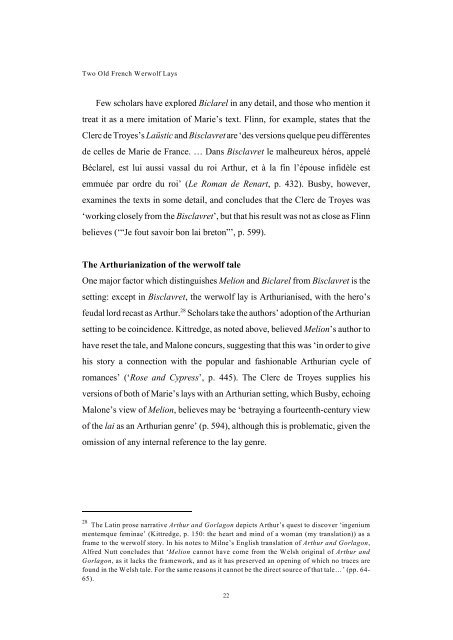Melion and Biclarel - University of Liverpool
Melion and Biclarel - University of Liverpool
Melion and Biclarel - University of Liverpool
You also want an ePaper? Increase the reach of your titles
YUMPU automatically turns print PDFs into web optimized ePapers that Google loves.
Two Old French Werwolf Lays<br />
Few scholars have explored <strong>Biclarel</strong> in any detail, <strong>and</strong> those who mention it<br />
treat it as a mere imitation <strong>of</strong> Marie’s text. Flinn, for example, states that the<br />
Clerc de Troyes’s Laüstic <strong>and</strong> Bisclavret are ‘des versions quelque peu différentes<br />
de celles de Marie de France. … Dans Bisclavret le malheureux héros, appelé<br />
Béclarel, est lui aussi vassal du roi Arthur, et à la fin l’épouse infidèle est<br />
emmuée par ordre du roi’ (Le Roman de Renart, p. 432). Busby, however,<br />
examines the texts in some detail, <strong>and</strong> concludes that the Clerc de Troyes was<br />
‘working closely from the Bisclavret’, but that his result was not as close as Flinn<br />
believes (‘“Je fout savoir bon lai breton”’, p. 599).<br />
The Arthurianization <strong>of</strong> the werwolf tale<br />
One major factor which distinguishes <strong>Melion</strong> <strong>and</strong> <strong>Biclarel</strong> from Bisclavret is the<br />
setting: except in Bisclavret, the werwolf lay is Arthurianised, with the hero’s<br />
28<br />
feudal lord recast as Arthur. Scholars take the authors’ adoption <strong>of</strong> the Arthurian<br />
setting to be coincidence. Kittredge, as noted above, believed <strong>Melion</strong>’s author to<br />
have reset the tale, <strong>and</strong> Malone concurs, suggesting that this was ‘in order to give<br />
his story a connection with the popular <strong>and</strong> fashionable Arthurian cycle <strong>of</strong><br />
romances’ (‘Rose <strong>and</strong> Cypress’, p. 445). The Clerc de Troyes supplies his<br />
versions <strong>of</strong> both <strong>of</strong> Marie’s lays with an Arthurian setting, which Busby, echoing<br />
Malone’s view <strong>of</strong> <strong>Melion</strong>, believes may be ‘betraying a fourteenth-century view<br />
<strong>of</strong> the lai as an Arthurian genre’ (p. 594), although this is problematic, given the<br />
omission <strong>of</strong> any internal reference to the lay genre.<br />
28<br />
The Latin prose narrative Arthur <strong>and</strong> Gorlagon depicts Arthur’s quest to discover ‘ingenium<br />
mentemque feminae’ (Kittredge, p. 150: the heart <strong>and</strong> mind <strong>of</strong> a woman (my translation)) as a<br />
frame to the werwolf story. In his notes to Milne’s English translation <strong>of</strong> Arthur <strong>and</strong> Gorlagon,<br />
Alfred Nutt concludes that ‘<strong>Melion</strong> cannot have come from the Welsh original <strong>of</strong> Arthur <strong>and</strong><br />
Gorlagon, as it lacks the framework, <strong>and</strong> as it has preserved an opening <strong>of</strong> which no traces are<br />
found in the Welsh tale. For the same reasons it cannot be the direct source <strong>of</strong> that tale…’ (pp. 64-<br />
65).<br />
22
















